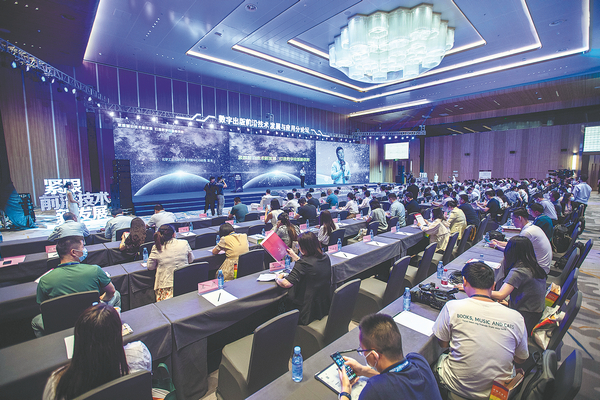

New era looms and promises a success story for the industry, Wang Ru reports.
Last year, artist Jason Allen took first place in the digital category of the Colorado State Fair's annual art competition with his painting Theatre d'Opera Spatial. Later, he admitted on Twitter that the work was created with Midjourney, an artificial intelligence tool that can turn texts into hyperrealistic graphics.
The news aroused a fierce backlash from artists who accused him of cheating, but Allen said he didn't break any rules or deceive anyone about its origin, and refused to apologize.
The story was told by Si Xiao, director of the Tencent Research Institute, as an example of the influence AI can exert on artistic creation. And going further, it may bring new tendencies in digital publishing, said Si, during a forum on the development and application of new technology in digital publishing, which, as a sub-forum of the Forum on Building up China's Cultural Strength, was held on June 8 in Shenzhen, Guangdong province.
Organized by the publishing bureau of the Publicity Department of the Communist Party of China Central Committee, the sub-forum brought together entrepreneurs, government officials and scholars to discuss the application of cutting-edge technology in digital publishing, the challenges in this process, and the development trends.
Publishing has a long history in China. In the Spring and Autumn Period (770-476 BC), words were put down on bamboo and wooden slips and those who wrote or compiled such books were limited to the aristocracy, according to Wang Ying, vice-president of tech giant Baidu, at the forum. In the Han Dynasty (206 BC-AD 220), the birth of papermaking technique brought the start of publishing, leading to an increasing amount of literature, and more people were able to approach books, she says.
When printing techniques were invented in the Tang Dynasty (618-907), publishing developed officially. In the 1970s, the appearance of the internet enabled words to be digitalized for the first time, she adds.
"With the continuous development of information technology, the digital publishing industry is in a stage of rapid development, among which digital books, digital newspapers and magazines, net-casting and many other fields have become an indispensable part of the cultural industry," says Wang Qiang, director of the United Front Work Department of the CPC Shenzhen Committee.
Sun Bo, chief information officer of the Southern Publishing and Media Group, says statistics released by the Chinese Academy of Press and Publication shows the industrial scale of China's digital publishing was 137.7 billion yuan ($19.1 billion) in 2011, and in 2021, the number reached 1.28 trillion, more than nine times that of a decade ago.
"The rapid growth of digital publishing not only brings readers a more convenient and richer reading experience, but also provides publishing enterprises with broader room for development," says Wang Qiang.
According to Wang Ying, the concept of artificial intelligence-generated content, or AIGC, is recognized this year, and people have seen a blowout development of applications in this field.
"In the next two years, AIGC will have a more prosperous development, with its generated content not only usable, but easy to use and even profitable. The development of AIGC urges a new wave of attention on AI from people across the world," she says.
She illustrates on how AIGC applications, such as Ernie Bot developed by Baidu, can help in online novel creating and publishing, from the perspectives of creators and publishers.
From creators' perspective, AIGC helps them enhance efficiency tremendously. According to her, many details in a writer's creation, like background checks, logic organizing, setting up chapters and revising words, can take up much of their time.